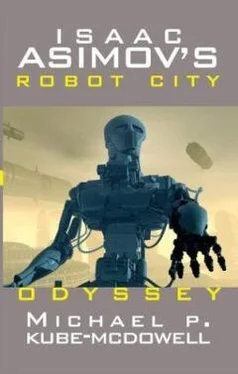Michael Kube-McDowell - Odyssey
Здесь есть возможность читать онлайн «Michael Kube-McDowell - Odyssey» весь текст электронной книги совершенно бесплатно (целиком полную версию без сокращений). В некоторых случаях можно слушать аудио, скачать через торрент в формате fb2 и присутствует краткое содержание. Год выпуска: 2004, ISBN: 2004, Издательство: I Books, Жанр: Фантастика и фэнтези, на английском языке. Описание произведения, (предисловие) а так же отзывы посетителей доступны на портале библиотеки ЛибКат.
- Название:Odyssey
- Автор:
- Издательство:I Books
- Жанр:
- Год:2004
- ISBN:ISBN: 0-743-47924-6
- Рейтинг книги:3 / 5. Голосов: 1
-
Избранное:Добавить в избранное
- Отзывы:
-
Ваша оценка:
- 60
- 1
- 2
- 3
- 4
- 5
Odyssey: краткое содержание, описание и аннотация
Предлагаем к чтению аннотацию, описание, краткое содержание или предисловие (зависит от того, что написал сам автор книги «Odyssey»). Если вы не нашли необходимую информацию о книге — напишите в комментариях, мы постараемся отыскать её.
Odyssey — читать онлайн бесплатно полную книгу (весь текст) целиком
Ниже представлен текст книги, разбитый по страницам. Система сохранения места последней прочитанной страницы, позволяет с удобством читать онлайн бесплатно книгу «Odyssey», без необходимости каждый раз заново искать на чём Вы остановились. Поставьте закладку, и сможете в любой момент перейти на страницу, на которой закончили чтение.
Интервал:
Закладка:
But Derec had been thinking about something else. The caninoid was treating him in a way that could only be called friendly, and was the best prospect for an ally aboard the raider ship besides. If they were going to be working together, it was time for Derec to stop thinking of the alien as it. Or even she.
“First things first. I can’t say your name even as well as Aranimas does-”
“Thass pretty low standard.”
“-but I have to call you something. Can you live with Wolruf?”
“Iss not my name, but I know who ‘u mean when ‘u say it.”
“That’s all I wanted. Wolruf, I’ve got some fine print to read. What can you find me to read it with?”
“I get ‘u something,” she promised.
The magnifying scanner that Wolruf came up with was an inspection instrument of some sort. It had a display screen rather than an eyepiece, a fixed focus, and a tiny field of view. But the incident lighting at the aperture highlighted perfectly the fine grooves of the serial number engraving, making up for all the other shortcomings.
With Wolruf peering over his shoulder, Derec scanned the fifteen lines of data. “Do you read Standard, too?”
“No,” Wolruf said. “Tell ‘u a secret-I learn Standard so I not ‘ave to lissen to Aranimas mangle my language.”
Derec laughed, and the sound startled Wolruf. “What I’m looking at is one of the robot’s identification gratings. It’ll tell me several things that will help me fix the damage the manufacturer, the model, the date of initialization, any customization parameters,” he said breezily.
He went on like that awhile longer, loading his explanation with as many technical terms as he could in the hopes of appearing to be open and cooperative while actually explaining nothing. He did not mention that if the robot were from Earth, the grating would also tell who owned it, or that the three cryptic lines of symbols at the bottom of the screen were the programming access codes and the initialization sequence, the keys that would allow him to do more than merely repair the robot, but to alter its programming.
“What does it say?”
“This one is a Ferrier Model EG,” Derec said, scanning. “Customized for valet service.” And personal defense, he added silently. A bodyguard robot. “Initialization date, Standard Year ‘83-”
Then he scanned a few words ahead and was struck dumb.
“What is it?” Wolruf asked. “Is something wrong?”
“No,” Derec managed to say. “The robot was registered on Aurora.”
“That iss one of ‘urr worlds?”
“Yes.”
“Iss that important?”
“No,” Derec said. “Let’s look at the other one.” But it was important, and his hands were trembling as he took the scanner in them and rose from his seat. He remembered Aurora. He remembered the World of the Dawn. Not the things that everyone knew-that it was the first Spacer world and long the preeminent one, that it was home to the highly regarded Institute of Robotics from which most advances in robotic science had emerged.
No, like a ray of light sneaking past the black curtain, Derec remembered Aurora as a place he had been: glimpses of a spaceport, a parklike city, a pastoral countryside. He was connected with it in some way, some way strong enough that the word alone had the power to break through the wall separating him from his past.
At last, he knew something about himself. He had been to Aurora. It was not much of a biography, but it was a beginning.
Chapter 9. Ally
Without a diagnostic board or even a computer at his disposal, Derec had no choice but to activate the robot and rely on its own self-diagnostic capabilities. But before he could get even that far, he had a jigsaw puzzle to assemble.
The headless robot was an EX series, but the differences did not affect the parts Derec needed to borrow to make the EG whole. The active systems-as opposed to the merely structural-of any mass-produced robot were modular and standardized. It would not have been possible to produce them economically any other way. So the kidney-sized microfusion powerpack of the EX was a plug-compatible replacement for the damaged one inside the EG.
But the powerpack’s mounting cradle, which contained the interface for the primary power bus, had also been damaged by the fight which had downed the robot. Regrettably, the cradle had not been designed for field replacement, and it seemed to be attached to every other component inside the EG’s torso-and not by convenient micromagnetic fields. The manufacturer had settled for the less costly alternative of sonic welds.
Lacking the proper tools, swapping the cradles was a challenge. He practiced on the damaged cradle inside the EG, then used his hard-won expertise to transfer the undamaged one into the vacancy. That alone took more than two hours. But when he was done, it took less than two minutes to swap powerpacks.
Unfortunately, that did not end the matter. In all Ferrier models, the basic data library used by the robot was contained in removable memory cubes placed in a compartment just behind its “collarbone.” The robot’s extensive positronic memory was reserved completely for the business of learning from experience.
From the manufacturer’s standpoint, that arrangement meant that the positronic brains did not have to be specialized according to the robot’s function. From the owner’s viewpoint, it meant that their investment was protected against obsolescence or changing needs.
But from Derec’s perspective, it meant trouble. The headless robot had five cube slots, four of them occupied. For the EG, the numbers were seven and five. But the two empty slots and three of the occupied ones had been caught in the same blast that had damaged the power cradle.
There was no repairing them and no replacing them. But what was worse was that Derec was bound to use one of the two functional slots for the standard Systems cube, without which the robot would know nothing about its own structure and operation. He had five cubes packed full of data and logic routines, and he could only use one of them at a time. Eventually he settled on the Mathematics cube, concealing the Personal Defense cube for possible use at some future time.
Derec’s inventory of visible damage to the robot included severed cables that would render the right arm paralyzed and a frozen gimbal on one of the dual gyroscopes. But with power and the working library restored, there was only one truly critical part left to see to: the positronic brain.
In appearance, the brain was a three-pound lump of platinum-iridium. In function, it was the repository for the fundamental positromotive potentials governing the robot’s activity, for the temporary potentials which represented thought and decision, and for the pathways which represented learning.
What Derec was hoping was that the fundamental pathways had not been randomized, as could happen if the brain had been exposed to hard radiation. There was no hope for the robot’s experience base. The backup microcell, used to refresh the pathways while the robot was being serviced, had long since been exhausted and the pathways had long ago decayed. The robot would remember nothing of its previous service. But if the brain was undamaged, it should function normally when reinitiated.
Just like me-
Given the equipment available, the only way to test the condition of the positronic brain was to activate the robot and test it. For obvious reasons, that was dangerous. At one point in the history of robotics, robots had been designed to shut down when they detected any internal error conditions. But several hundred years of progress in robotics design had produced a different philosophy built around fault-tolerance and self-maintenance. He could not be sure what would happen.
Читать дальшеИнтервал:
Закладка:
Похожие книги на «Odyssey»
Представляем Вашему вниманию похожие книги на «Odyssey» списком для выбора. Мы отобрали схожую по названию и смыслу литературу в надежде предоставить читателям больше вариантов отыскать новые, интересные, ещё непрочитанные произведения.
Обсуждение, отзывы о книге «Odyssey» и просто собственные мнения читателей. Оставьте ваши комментарии, напишите, что Вы думаете о произведении, его смысле или главных героях. Укажите что конкретно понравилось, а что нет, и почему Вы так считаете.












